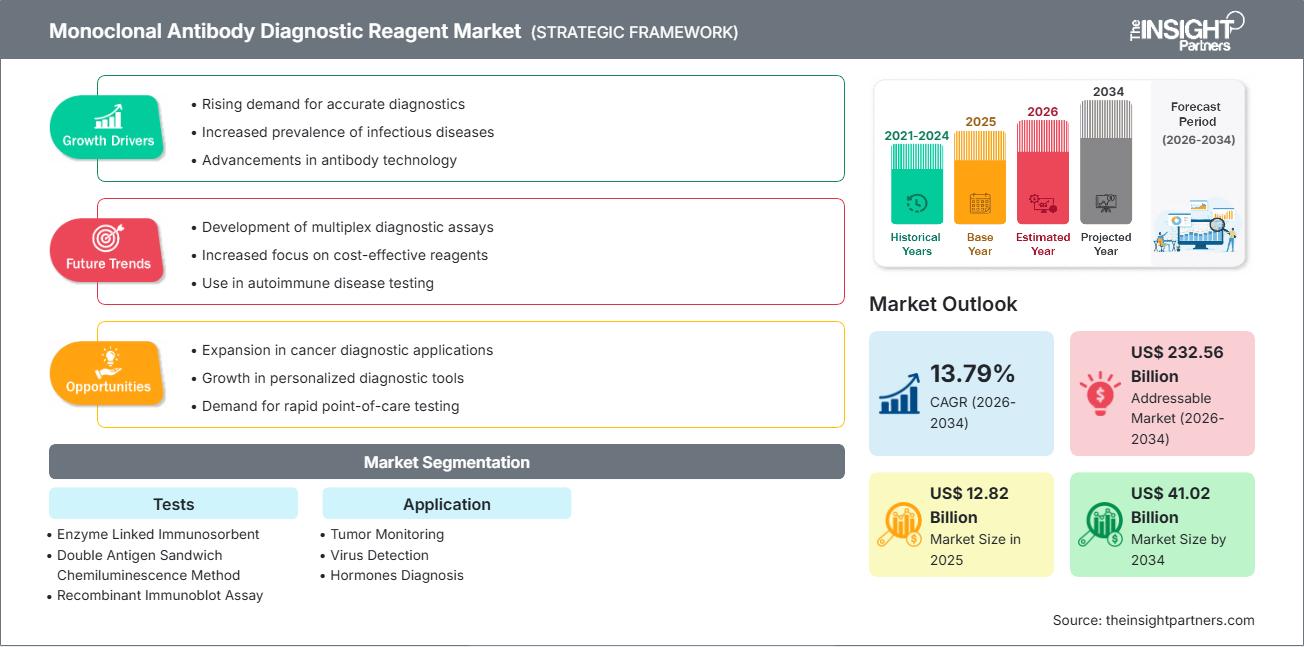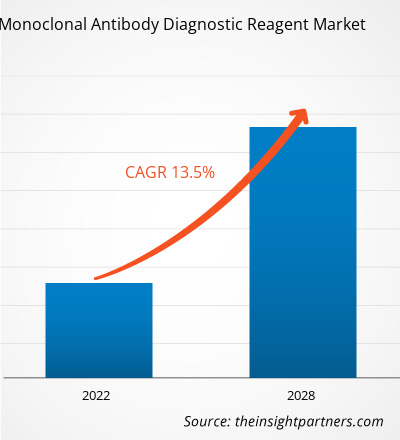Der Markt für monoklonale Antikörper-Diagnostika wird bis 2034 voraussichtlich ein Volumen von 41,02 Milliarden US-Dollar erreichen, gegenüber 12,82 Milliarden US-Dollar im Jahr 2025. Es wird erwartet, dass der Markt im Zeitraum 2026–2034 eine durchschnittliche jährliche Wachstumsrate (CAGR) von 13,79 % verzeichnen wird.
Marktanalyse für monoklonale Antikörper-Diagnostika
Der Markt für monoklonale Antikörper (mAb) als Diagnostikreagenzien verzeichnet ein starkes Wachstum, vor allem getrieben durch die zunehmende Verbreitung chronischer Erkrankungen wie Krebs, Autoimmunerkrankungen und Infektionskrankheiten, die eine frühzeitige und präzise Diagnose erfordern. Monoklonale Antikörper sind aufgrund ihrer hohen Spezifität und Affinität zu Zielantigenen (Biomarkern, Hormonen oder mikrobiellen Produkten) essenzielle Bestandteile diagnostischer Tests. Diese Reagenzien werden in verschiedenen In-vitro-Diagnostikverfahren (IVD) umfassend eingesetzt. Fortschritte in der Biotechnologie, insbesondere die Fähigkeit zur Herstellung hochspezifischer, konsistenter und wenig toxischer humanisierter oder humaner mAbs, beschleunigen deren Anwendung in klinischen Laboren und Forschungseinrichtungen weltweit. Das Marktwachstum wird zudem positiv durch intensive Forschungs- und Entwicklungsaktivitäten zur Entwicklung neuartiger diagnostischer Tests sowie durch eine vielversprechende Pipeline an diagnostischen Tests in der klinischen Prüfung beeinflusst.
Marktübersicht für monoklonale Antikörper-Diagnostika
Monoklonale Antikörper (mAbs) sind entscheidende Sonden in der biomedizinischen und mikrobiologischen Forschung und unverzichtbar für moderne Diagnoseverfahren. Das Prinzip beruht auf der spezifischen Bindung von mAbs an Zielantigene in Patientenproben (wie Blut oder Urin), wodurch Krankheitsmarker präzise identifiziert und quantifiziert werden können. Diagnostische Reagenzien, die mittels Hybridom- oder rekombinanter Technologie hergestellt werden, ermöglichen die für die moderne Gesundheitsversorgung notwendige groß angelegte und reproduzierbare Analyse. Aktuell nutzt jedes große Diagnostiklabor mAb-basierte Verfahren. Die Möglichkeit der Kopplung von mAbs mit Fluoreszenzfarbstoffen oder Enzymen macht sie zu unverzichtbaren Werkzeugen in Techniken wie der Immunhistochemie und dem ELISA. Dies erleichtert die Früherkennung von Krankheiten, die Überwachung des Behandlungserfolgs und die Entwicklung personalisierter Therapieansätze.
Passen Sie diesen Bericht Ihren Anforderungen an.
Sie erhalten eine kostenlose Anpassung aller Berichte – einschließlich Teilen dieses Berichts, Länderanalysen und Excel-Datenpaketen – sowie attraktive Angebote und Rabatte für Start-ups und Universitäten.
Markt für monoklonale Antikörper-Diagnostika: Strategische Einblicke

-
Ermitteln Sie die wichtigsten Markttrends dieses Berichts.Diese KOSTENLOSE Probe beinhaltet eine Datenanalyse, die von Markttrends bis hin zu Schätzungen und Prognosen reicht.
Markttreiber und Chancen für monoklonale Antikörper-Diagnostika
Markttreiber:
- Zunehmende Verbreitung chronischer Krankheiten: Die weltweit steigende Inzidenz von Krebserkrankungen, Autoimmunerkrankungen (z. B. rheumatoide Arthritis) und Infektionskrankheiten führt zu einer massiven Nachfrage nach spezifischen und zuverlässigen Diagnoseinstrumenten zur Früherkennung und Krankheitsüberwachung.
- Umfangreiche Forschungs- und Entwicklungsbemühungen zur Entwicklung neuartiger Therapien: Signifikante Investitionen von Pharma- und Biotechnologieunternehmen in Forschung und Entwicklung führen zur Entdeckung neuer Krankheitsbiomarker und zur anschließenden Entwicklung hochspezifischer monoklonaler Antikörper (mAb) zur deren Nachweis. Dies umfasst eine vielversprechende Pipeline neuer Medikamente und Diagnosetests.
- Fortschritte in der Biotechnologie: Innovationen in der Gentechnik, Zellkultursystemen und Protein-Engineering ermöglichen die Entwicklung effektiverer, hochspezifischer und weniger immunogener humaner und humanisierter monoklonaler Antikörper und verbessern so die Leistungsfähigkeit diagnostischer Tests.
Marktchancen:
- Expansion in neue therapeutische/diagnostische Bereiche: Monoklonale Antikörper werden über traditionelle Anwendungen hinaus erforscht, um neurologische Störungen, seltene genetische Erkrankungen und ein immer breiteres Spektrum an Infektionskrankheiten zu diagnostizieren, wodurch sich der Markt erweitert.
- Zunehmender Einsatz von Multiplex-Assays: Der wachsende Trend, Multiplex-Assays zur Messung mehrerer Analyten (Proteine, Biomarker) in einer einzigen Probe einzusetzen, führt zu einer Nachfrage nach verschiedenen hochspezifischen mAb-Reagenzien für eine effiziente und durchsatzstarke Diagnostik, insbesondere in der Onkologie und der Diagnostik von Infektionskrankheiten.
- Zunehmende personalisierte Medizin: Der Wandel hin zur personalisierten Medizin, die auf der Anpassung der medizinischen Behandlung an individuelle molekulare Profile beruht, nutzt in großem Umfang mAb-Diagnostika zur Erkennung spezifischer krankheitsassoziierter Biomarker.
Marktbericht für monoklonale Antikörper-Diagnostika: Segmentierungsanalyse
Der Marktanteil von monoklonalen Antikörper-Diagnostika wird in verschiedenen Segmenten analysiert, wobei die typische Segmentierung von dem bereitgestellten KI-Entwurf abweicht.
Durch Tests:
- Enzymgebundener Immunadsorptionstest: Besitzt aufgrund seiner etablierten Zuverlässigkeit, hohen Sensitivität und Kosteneffizienz einen dominanten Marktanteil beim Nachweis einer breiten Palette von Antigenen/Antikörpern (z. B. beim Virusnachweis, Hormonspiegel).
- Doppelantigen-Sandwich-Chemilumineszenzmethode: Eine hochempfindliche und quantitative Methode, die sich besonders für den spezifischen Nachweis von Proteinen eignet.
- Rekombinanter Immunoblot-Assay: Wird für komplexe oder bestätigende Diagnostik eingesetzt.
- Dot-Immunogold-Filtrationstest: Wird für die schnelle Diagnostik eingesetzt.
Auf Antrag:
- Tumormonitoring: Hält den größten Marktanteil, was auf die entscheidende Rolle von monoklonalen Antikörpern bei der Erkennung von Krebsbiomarkern für Diagnose, Prognose und Überwachung des Therapieansprechens zurückzuführen ist.
- Virusnachweis: Wird zur Diagnose von Infektionskrankheiten wie Hepatitis, HIV und Influenza eingesetzt.
- Hormondiagnostik: Dient zur Messung der Konzentrationen verschiedener Hormone im Blut.
Nach Geographie:
- Nordamerika
- Europa
- Asien-Pazifik
- Süd- und Mittelamerika
- Naher Osten und Afrika
Markteinblicke in den Markt für monoklonale Antikörper-Diagnostika
Die regionalen Trends und Einflussfaktoren auf den Markt für monoklonale Antikörper-Diagnostika im gesamten Prognosezeitraum wurden von den Analysten von The Insight Partners eingehend erläutert. Dieser Abschnitt behandelt außerdem die Marktsegmente und die geografische Verteilung des Marktes für monoklonale Antikörper-Diagnostika in Nordamerika, Europa, Asien-Pazifik, dem Nahen Osten und Afrika sowie Süd- und Mittelamerika.
Berichtsumfang zum Markt für monoklonale Antikörper-Diagnostika
| Berichtattribute | Details |
|---|---|
| Marktgröße im Jahr 2025 | 12,82 Milliarden US-Dollar |
| Marktgröße bis 2034 | 41,02 Milliarden US-Dollar |
| Globale durchschnittliche jährliche Wachstumsrate (2026 - 2034) | 13,79 % |
| Historische Daten | 2021-2024 |
| Prognosezeitraum | 2026–2034 |
| Abgedeckte Segmente |
Durch Tests
|
| Abgedeckte Regionen und Länder |
Nordamerika
|
| Marktführer und wichtige Unternehmensprofile |
|
Marktdichte der Akteure im Markt für monoklonale Antikörper-Diagnostika: Auswirkungen auf die Geschäftsdynamik verstehen
Der Markt für monoklonale Antikörper-Diagnostika wächst rasant, angetrieben durch die steigende Nachfrage der Endverbraucher. Gründe hierfür sind unter anderem sich wandelnde Verbraucherpräferenzen, technologische Fortschritte und ein wachsendes Bewusstsein für die Vorteile des Produkts. Mit steigender Nachfrage erweitern Unternehmen ihr Angebot, entwickeln innovative Lösungen, um den Verbraucherbedürfnissen gerecht zu werden, und nutzen neue Trends, was das Marktwachstum zusätzlich beflügelt.

- Überblick über die wichtigsten Akteure auf dem Markt für monoklonale Antikörper-Diagnostika
Marktanteilsanalyse für monoklonale Antikörper-Diagnostika nach Regionen
Nordamerika wird voraussichtlich den Markt für monoklonale Antikörper-Diagnostika dominieren. Diese Dominanz beruht auf der starken Präsenz führender biopharmazeutischer und diagnostischer Unternehmen, einer fortschrittlichen Gesundheitsinfrastruktur, erheblichen Investitionen in Forschung und Entwicklung im Bereich der Lebenswissenschaften sowie einer hohen Akzeptanz fortschrittlicher Diagnosetechnologien wie der personalisierten Medizin.
Der Markt weist je nach regionalen Faktoren unterschiedliche Wachstumsverläufe auf:
-
Nordamerika
- Marktanteil: Besitzt den höchsten Marktanteil, was auf eine robuste Forschung und Entwicklung, fortschrittliche Gesundheitsversorgung und die schnelle Einführung neuer Diagnosetechnologien zurückzuführen ist.
- Wichtigste Einflussfaktoren: Hohe Gesundheitsausgaben, Präsenz großer Diagnostik- und Biotechnologieunternehmen sowie günstige Erstattungspolitik.
- Trends: Fokus auf molekulare Diagnostik, Biomarker-Entdeckung und Integration von KI/ML in die Diagnostik.
-
Europa
- Marktanteil: Ein bedeutender Markt mit starkem Fokus auf qualitativ hochwertige Diagnostik und strengen regulatorischen Standards (z. B. IVDR).
- Wichtigste Einflussfaktoren: Staatliche Förderung der Gesundheitsforschung, hohe Prävalenz chronischer Krankheiten und gemeinsame Forschungsinitiativen.
- Trends: Wachstum bei patientennahen Diagnostikverfahren und zunehmender Einsatz fortschrittlicher immunodiagnostischer Plattformen.
-
Asien-Pazifik
- Marktanteil: Voraussichtlich wird es sich um den am schnellsten wachsenden regionalen Markt handeln, angetrieben durch den raschen Ausbau der Gesundheitsinfrastruktur.
- Wichtigste Einflussfaktoren: Wachsende Investitionen in Forschung und Entwicklung durch internationale und inländische Akteure (insbesondere in China und Indien), steigendes verfügbares Einkommen und eine große, alternde Patientenpopulation.
- Trends: Steigende Nachfrage nach kostengünstigen Diagnoselösungen und staatlich geförderten Programmen zur Verbesserung des Zugangs zur Gesundheitsversorgung.
-
Süd- und Mittelamerika
- Marktanteil: Ein aufstrebender Markt mit zunehmendem Zugang zu hochentwickelten Diagnoseinstrumenten.
- Wichtigste Treiber: Modernisierung der Gesundheitseinrichtungen und zunehmende Investitionen des öffentlichen und privaten Sektors in das Management chronischer Krankheiten.
- Trends: Zunehmende Nutzung importierter Diagnostik-Kits und lokaler Fertigungspartnerschaften.
-
Naher Osten und Afrika
- Marktanteil: Ein aufstrebender Markt mit starkem Wachstumspotenzial, angeführt von Initiativen zur digitalen Transformation in den VAE und Saudi-Arabien.
- Wichtigste Einflussfaktoren: Strategische nationale Digitalisierungs- und Gesundheitsstrategien sowie verstärkte Aufklärungs- und Screeningprogramme für Infektionskrankheiten und chronische Krankheiten.
- Trends: Zunehmende Integration fortschrittlicher Diagnoseplattformen in großen Krankenhäusern und Diagnosezentren.
Marktdichte der Akteure im Markt für monoklonale Antikörper-Diagnostika: Auswirkungen auf die Geschäftsdynamik verstehen
Der Markt für monoklonale Antikörper-Diagnostika ist hart umkämpft und wird von globalen Life-Science-Konzernen, spezialisierten Herstellern von Diagnostik-Kits und regionalen Anbietern dominiert. Der Wettbewerb wird durch den Bedarf an höherer Sensitivität, Spezifität und schnelleren Ergebnissen in der Diagnostik angetrieben. Die Unternehmen investieren aktiv in Innovationen, um ihre Marktposition zu stärken und die wachsende Nachfrage nach präzisen Früherkennungsmethoden zu decken.
Der Wettbewerb zwingt die Anbieter dazu, sich durch Folgendes zu differenzieren:
- Schwerpunkt ist die Entwicklung hochspezifischer rekombinanter monoklonaler Antikörper und neuartiger Konjugationstechniken zur Verbesserung der Testleistung und Stabilität.
- Partnerschaften zwischen Reagenzienherstellern und IVD-Plattformanbietern zur Sicherstellung von Kompatibilität und Marktzugang.
- Strikte Einhaltung regulatorischer Standards (z. B. FDA, CE-IVD), um die Zuverlässigkeit und den klinischen Nutzen ihrer Produkte zu gewährleisten.
Chancen und strategische Schritte
- Fokus auf Multiplex-Diagnostik: Unternehmen nutzen fortschrittliche Technologien, um Diagnosepanels zu entwickeln, die gleichzeitig mehrere Krankheitsbiomarker erkennen können, umfassende Erkenntnisse über den Patienten liefern und neue Einnahmequellen erschließen.
- Investitionen in Schwellenländer: Große Akteure erweitern ihre Vertriebsnetze und lokalen Produktionskapazitäten in wachstumsstarken Regionen wie dem asiatisch-pazifischen Raum, um die steigende Nachfrage zu bedienen.
- M&A-Aktivitäten: Fusionen und Übernahmen sind üblich, da große Diagnostikunternehmen spezialisierte Startups erwerben, um neuartige Antikörpertechnologien oder Nischenkrankheitsmarker in ihr Portfolio zu integrieren.
Die wichtigsten Unternehmen, die auf dem Markt für monoklonale Antikörper-Diagnostika tätig sind, sind:
- BioGenex
- Bio-Rad Laboratories, Inc.
- Biocare Medical, LLC
- Celltrion Healthcare Co., Ltd.
- Kreative Diagnostik
- GenWay Biotech
- Thermo Fisher Scientific Inc.
- ABclonal, Inc.
- Apto-Gen
Hinweis: Die oben aufgeführten Unternehmen sind nicht in einer bestimmten Reihenfolge angeordnet.
Neuigkeiten und aktuelle Entwicklungen auf dem Markt für monoklonale Antikörper-Diagnostika
- Am 29. Oktober 2025 gab beispielsweise Thermo Fisher Scientific Inc., der weltweit führende Anbieter von Dienstleistungen für die Wissenschaft, eine endgültige Vereinbarung zur Übernahme von Clario Holdings, Inc., einem führenden Anbieter von Endpunktdatenlösungen für klinische Studien, von einer Aktionärsgruppe unter der Führung von Astorg und Nordic Capital, Novo Holding und Cinven für 8,875 Milliarden US-Dollar in bar zum Abschluss der Transaktion zuzüglich potenzieller zusätzlicher erfolgsabhängiger Zahlungen und anderer Zahlungen in der Zukunft bekannt, die größtenteils von der Leistung abhängen.
- Am 23. Juni 2025 gab Creative Diagnostics, ein führender Hersteller und Lieferant von Antikörpern, Antigenen und Testkits, die Markteinführung seiner neuen Produktlinie humaner Hybrid-IgM-Kontroll-Monoklonalantikörper für Forschungszwecke bekannt, die eine Reihe von Krankheiten wie CMV, HSV, MeV, MuV, RuV und VZV abdecken.
- Am 17. Juni 2025 erweiterte Bio-Rad Laboratories, Inc., ein weltweit führendes Unternehmen im Bereich der Life-Science-Forschung und klinischen Diagnostik, sein Angebot an rekombinanten monoklonalen anti-idiotypischen Antikörpern um Antikörper gegen Pertuzumab (Perjeta), Guselkumab (Tremfya), Canakinumab (Ilaris), Belimumab (Benlysta) und den bispezifischen Wirkstoff Emicizumab (Hemlibra). Zudem wurde das Sortiment der SpyCatcher-Reagenzien um Human IgM-FcSpyCatcher erweitert.
Marktbericht für monoklonale Antikörper-Diagnostika: Abdeckung und Ergebnisse
Der Bericht „Marktgröße und Prognose für monoklonale Antikörper-Diagnostika (2021–2034)“ bietet eine detaillierte Analyse des Marktes und deckt folgende Bereiche ab:
- Marktgröße und Prognose für monoklonale Antikörper-Diagnostika auf globaler, regionaler und Länderebene für alle wichtigen Marktsegmente, die im Rahmen des Berichts abgedeckt werden
- Markttrends für monoklonale Antikörper-Diagnostika sowie Marktdynamiken wie Treiber, Hemmnisse und wichtige Chancen
- Detaillierte PEST- und SWOT-Analyse
- Marktanalyse für monoklonale Antikörper-Diagnostika: Wichtige Markttrends, globale und regionale Rahmenbedingungen, Hauptakteure, regulatorische Bestimmungen und aktuelle Marktentwicklungen
- Branchenlandschaft und Wettbewerbsanalyse mit Fokus auf Marktkonzentration, Heatmap-Analyse, führende Akteure und aktuelle Entwicklungen im Markt für monoklonale Antikörper-Diagnostika. Ausführliche Unternehmensprofile.
- Historische Analyse (2 Jahre), Basisjahr, Prognose (7 Jahre) mit CAGR
- PEST- und SWOT-Analyse
- Marktgröße Wert/Volumen – Global, Regional, Land
- Branchen- und Wettbewerbslandschaft
- Excel-Datensatz
Aktuelle Berichte
Erfahrungsberichte
Grund zum Kauf
- Fundierte Entscheidungsfindung
- Marktdynamik verstehen
- Wettbewerbsanalyse
- Kundeneinblicke
- Marktprognosen
- Risikominimierung
- Strategische Planung
- Investitionsbegründung
- Identifizierung neuer Märkte
- Verbesserung von Marketingstrategien
- Steigerung der Betriebseffizienz
- Anpassung an regulatorische Trends






















 Kostenlose Probe anfordern für - Markt für monoklonale Antikörper-Diagnostika
Kostenlose Probe anfordern für - Markt für monoklonale Antikörper-Diagnostika